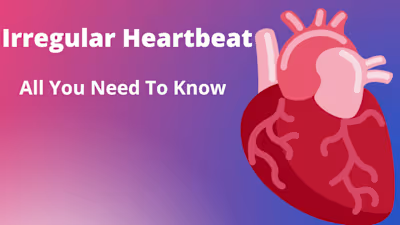What is an ECG: The Simple Guide

Detecting changes in how your heart is working is important, because it may signal early signs of a developing condition.
ECGs are one of the best ways to detect and monitor a heart condition before it worsens or becomes a serious health problem.
What is an Electrocardiography?
Electrocardiography(ECG) is a quick, easy, not painful non-invasive(not involving entering the body) procedure in which the heart’s electrical activity is amplified and recorded.
It is one of the most widely used tests in the world found in hospital wards, doctors’ offices, emergency departments, etc.
What is an Electrocardiogram?
An electrocardiogram(ECG) is the end product of electrocardiography. It is a record of how your heart is functioning. This record( the electrocardiogram) provides information about the
Rate and rhythm(pattern of your heartbeat)
Part of the heart that triggers a heartbeat.
Nerve conduction pathways of the heart.
In referring to the electrocardiogram, two abbreviations may be used: EKG(Elektrokardiogramm) or ECG(Electrocardiogram).
U. S. National Library of Medicine’s MedlinePlus said; “Both are correct and commonly used. EKG is based on the German spelling, elektrokardiogramm. EKG may be preferred over ECG to avoid confusion with an EEG, a test that measures brain waves.”
What is The Difference Between ECG And KardiaMobile?
KardiaMobile records a single-lead EKG, which provides you and your doctor with reliable information on your heart information. KardiaMobile can detect the most common arrhythmias—including AFib, Bradycardia, Tachycardia, etc. in just 30 seconds.
EKGs measure the electrical activity of your heart and are used in hospitals, and ambulances to detect irregularities with your heart rate or rhythm, which may be indicators of a heart condition such as atrial fibrillation (AFib).
KardiaMobile is a smart device that can record a medical-grade electrocardiogram (EKG) right on your smartphone.
What is an ECG Machine?
An ECG machine is just as it sounds. It is a tool that tracks the electrical activity of a client’s heart by tracing lines on paper that reflect the electrical impulses (beating) of the heart.
ECG machines are standard equipment in operating theaters( operating rooms), intensive care units, and ambulances.
Some personal devices, such as smartwatches, offer ECG monitoring. Ask your doctor if this is an option for you.
The Components Of an ECG Machine
The components of an EKG machine may be manufactured separately(depending on the type, analog electronics, or analog to digital convertors) and then assembled before packaging.
These components, including the electrodes, the amplifier, and the output device, can be supplied by outside manufacturers or made in-house.
Electrodes. Electrodes come in various shapes and sizes but they all have two components:
An adhesive substance that attaches to the skin to secure the electrode in place.
A substance that reduces the oily nature of the skin.
There are two types of electrodes: bipolar and unipolar. The Bipolar is placed on the limbs while the unipolar is placed on the chest.
Cable or Connecting Wires. These wires connect directly between the electrodes and the amplifier. The connecting wires transmit the signal read from the electrodes and send it to the amplifier.
An Amplifier. The amplifier reads the electrical signal in the heart and prepares it for the output device. It reads the electrical signals generated by the heart and sends them to a buffer.
The buffer stabilizes and translates the signal. The differential amplifier makes the signal 100 times stronger. The amplified signal allows for more accurate measurement.
The output. This is recorded on graph paper or the monitor, that displays the results of the test. Some EKG machines record the measurements into computers for analysis and interpretation.
Types Of an ECG Machine
Several types of ECG machines exist to help check for a variety of heart or lung conditions. ECGs’ are chosen according to the type of examination to be performed.
The 12-Lead ECG. This type of ECG is the standard for measuring your heart’s electrical function. Performed while you are lying still, this ECG records your heart’s electrical activity from 12 electrodes (sticky patches) on your chest, arms, and legs at the same time. The 12-Lead ECG is used to diagnose dysrhythmias(arrhythmias).
The 15-Lead ECG. This is similar to the 12-lead but with 3 additional chest leads and is used to diagnose right and left ventricular infarction.
The 18-Lead ECG. The 18-lead adds 3 additional leads to the 15-leads and is useful for early diagnosis and detection of myocardial ischemia and injury.
Other ECGs’. There are other ECG machines besides the ones mentioned above, like telemetry, ambulatory, and other digital wearables that also check the functioning activity of your heart.
How to Obtain an ElectroCardioGram (ECG)
The electrocardiogram is obtained by placing disposable electrodes in standard positions on the skin of the chest wall and extremities(hands and legs).
The number and placement of electrodes depend on the type of electrocardiogram that is being obtained.
Most continuous monitors use 2-5 electrodes, usually placed on the limbs and the chest.
These electrodes create an imagery line, called the lead, which serves as a reference point from which the electrical activity of the heart is viewed.
These electrodes measure the magnitude and direction of electrical currents in the heart during each heartbeat.
The electrodes are connected by wires to a machine, which produces a record (tracing) for each electrode. Each tracing shows the electrical activity of the heart from different angles.
The tracings constitute the ECG. ECG takes about 3 minutes and has no risks.
Reading And Interpreting an Electrocardiogram
An electrocardiogram (ECG) represents the electrical current moving through the heart during your heartbeat.
The movement of the current is divided into parts, and each part is given a name( an alphabetic designation in the ECG machine).
Each heartbeat begins with an impulse from the heart's pacemaker (sinus or sinoatrial node).
This impulse activates the upper part of the heart (atria).
The P wave represents the activation of the atria.
Next, the electrical current flows down to the lower part of the heart (ventricles).
The QRS complex represents the activation of the ventricles.
The electrical current then spreads back over the ventricles in the opposite direction.
This activity is called the recovery wave, which is represented by the T wave.
Some kinds of heart problems can often be seen on an ECG like:
A previous heart attack (myocardial infarction),
An abnormal heart rhythm (arrhythmia),
An inadequate supply of blood and oxygen to the heart (ischemia)
Excessive thickening (hypertrophy) of the heart's muscular walls.
Certain problems seen on an ECG can also suggest bulges (aneurysms) that develop in weak areas of the heart's walls. Aneurysms may result from a heart attack.
If the rhythm is abnormal (too fast, too slow, or irregular), the ECG may also indicate where in the heart the abnormal rhythm starts.
Such information helps doctors begin to determine the cause and the most appropriate treatment.
Summary
When talking about an ECG, several terminologies need to be explained like Electrocardiography(ECG), which is the procedure(test) performed to diagnose arrhythmias.
Electrocardiogram(ECG), the results, records, or the endproduct of electrocardiography.
Electrocardiography Machine(ECG Machine), is the equipment used to carry out electrocardiography.
Notwithstanding the terminologies, your healthcare provider uses an ECG to check and diagnose mostly heart conditions.
References
Like this project
Posted Jun 17, 2023
Detecting changes in how your heart is working is important, because it may signal early signs of a developing condition. ECGs are one of the best ways to dete…








